Correlation between Seismic Waves Velocity Changes and the Occurrence of Moderate Earthquakes at the Bending of the Eastern Carpathians (Vrancea)
Abstract
:1. Introduction
2. Methodology Used for Monitoring the Variation of Seismic Velocities in Time
3. Analysis of the Temporal Variation of Vp/Vs Ratios for Two Moderate Earthquakes That Occurred at the Bending of the Southeastern Carpathians
3.1. Temporal Variation of Vp/Vs Ratios Determined for the Subcrustal Earthquake
3.2. Temporal Variation of Vp/Vs Ratios Determined for the Crustal Earthquakes
4. Discussion
5. Conclusions
Author Contributions
Funding
Data Availability Statement
Acknowledgments
Conflicts of Interest
References
- Radulian, M.; Mandrescu, N.; Panza, G.; Popescu, E.; Utale, A. Characterization of Seismogenic Zones of Romania. Pure Appl. Geophys. 2000, 157, 57. [Google Scholar] [CrossRef]
- Diaconescu, M. Sisteme de Fracturi Active Crustale pe Teritoriul Romaniei. Ph.D. Thesis, University of Bucharest, Bucharest, Romania, 2017. [Google Scholar]
- Radu, C.; Apopei, I.; Utale, A. Contributions to the Study of the Seismicity of Romania. In Progrese in Fizica; Symposium: Cluj-Napoca, Romania, 1980. (In Romanian) [Google Scholar]
- Constantinescu, L.; Marza, V. A Computer-compiled and Computer-oriented Catalogue of Romania’s Earthquakes During a Millennium (AD 984—1979). Rev. Roum. Geol. Geophys. Geogr. Ser Geophys. 1980, 24, 171–191. [Google Scholar]
- Bala, A.; Raileanu, V.; Dinu, C.; Diaconescu, M. Crustal seismicity and active fault systems in Romania. Rom. Rep. Phys. 2015, 67, 1176–1191. [Google Scholar]
- Beşuţiu, L.; Manea, V.; Pomeran, M. Vrancea Seismic Zone as an Unstable Triple Junction: New Evidence from Observations and Numerical Modelling. In Proceedings of the 9th Congress of the Balkan Geophysical Society, Antalya, Turkey, 5–9 November 2017; European Association of Geoscientists & Engineers: Houten, The Netherlands, 2017. [Google Scholar]
- Royden, L.H. Evolution of retreating subduction boundaries formed during continental collision. Tectonics 1993, 12, 629–638. [Google Scholar] [CrossRef]
- Linzer, H.G. Kinematics of retreating subduction along the Carpathian arc, Romania. Geology 1996, 24, 167–170. [Google Scholar] [CrossRef]
- Gîrbacea, R.; Frisch, W. Slab in the wrong place: Lower lithospheric mantle delamination in the last stage of the Eastern Carpathian subduction retreat. Geology 1998, 26, 611–614. [Google Scholar] [CrossRef]
- Knapp, J.; Asencio, E.; Owens, T.; Helffrich, G. Integration of passive and active source seismology: Mapping lithospheric structure beneath Scotland. In Proceedings of the AGU Fall Meeting, San Francisco, CA, USA, 5–10 December 2005. [Google Scholar]
- Fillerup, M.A.; Knapp, J.H.; Knapp, C.C.; Raileanu, V. Mantle earthquakes in the absence of subduction? Continental delamination in the Romanian Carpathians. Lithosphere 2010, 2, 333–340. [Google Scholar] [CrossRef] [Green Version]
- Sperner, B.; Lorenz, F.; Bonjer, K.; Hettel, S.; Müller, B.; Wenzel, F. Slab break-off–abrupt cut or gradual detachment? New insights from the Vrancea Region (SE Carpathians, Romania). Terra Nova 2001, 13, 172–179. [Google Scholar] [CrossRef]
- Gvirtzman, Z. Partial detachment of a lithospheric root under the southeast Carpathians: Toward a better definition of the detachment concept. Geology 2002, 30, 51–54. [Google Scholar] [CrossRef]
- Göğüş, O.H.; Pysklywec, R.N.; Faccenna, C. Postcollisional lithospheric evolution of the Southeast Carpathians: Comparison of geodynamical models and observations. Tectonics 2016, 35, 1205–1224. [Google Scholar] [CrossRef]
- Ismail-Zadeh, A.; Panza, G.; Naimark, B. Stress in the descending relic slab beneath the Vrancea region, Romania. Pure Appl. Geophys. 2000, 157, 111–130. [Google Scholar] [CrossRef]
- Lorinczi, P.; Houseman, G. Lithospheric gravitational instability beneath the Southeast Carpathians. Tectonophysics 2009, 474, 322–336. [Google Scholar] [CrossRef]
- Trifu, C.I.; Radulian, M. Asperity distribution and percolation as fundamentals of an earthquake cycle. Phys. Earth Planet. Inter. 1989, 58, 277–288. [Google Scholar] [CrossRef]
- Oncescu, M.; Marza, V.I.; Rizescu, M.; Popa, M. The Romanian Earthquake Catalogue between 984–1997. In Vrancea Earthquakes: Tectonics, Hazard and Risk Mitigation; Wenzel, F., Ed.; Springer: Dordrecht, The Netherlands, 1999; pp. 43–47. [Google Scholar]
- Purcaru, G. The Vrancea, Romania, earthquake of March 4, 1977—A quite successful prediction. Phys. Earth Planet. Inter. 1979, 18, 274–287. [Google Scholar] [CrossRef]
- Enescu, D. New Data Regarding the Periodicity of Vrancea Earthquakes and Attempts to Give a Tectonophysical Explanation of this Periodicity. Stud. Res. Geophys. 1983, 21, 24–30. (In Romanian) [Google Scholar]
- Enescu, D.; Enescu, B.D. Possible Cause-Effect Relationships Between Vrancea (Romania) Earthquakes and Some Global Geophysical Phenomena. Nat. Hazards 1999, 19, 233–245. [Google Scholar] [CrossRef]
- Kirschvink, J.L. Earthquake Prediction by Animals: Evolution and Sensory Perception. Bull. Seismol. Soc. Am. 2000, 90, 312–323. [Google Scholar] [CrossRef] [Green Version]
- Moldovan, I.A.; Constantin, A.P.; Biagi, P.F.; Danila, D.T.; Moldovan, A.S.; Dolea, P.; Toader, V.E.; Maggipinto, T. The development of the romanian VLF/LF monitoring system as part of the international network for frontier research on earthquake precursors (INFREP). Rom. J. Phys. 2015, 60, 1203–1217. [Google Scholar]
- Nimiya, H.; Ikeda, T.; Tsuji, T. Spatial and temporal seismic velocity changes on Kyushu Island during the 2016 Kumamoto earthquake. Sci. Adv. 2017, 3, e1700813. [Google Scholar] [CrossRef] [Green Version]
- Ikeda, T.; Tsuji, T. Temporal change in seismic velocity associated with an offshore MW 5.9 Off-Mie earthquake in the Nankai subduction zone from ambient noise cross-correlation. Prog. Earth Planet. Sci. 2018, 5, 62. [Google Scholar] [CrossRef]
- Adams, R.D. The Haicheng, China, earthquake of 4 February 1975: The first successfully predicted major earthquake. Earthq. Eng. Struct. Dyn. 1976, 4, 423–437. [Google Scholar] [CrossRef]
- Neagoe, C.; Manea, L.M.; Marmureanu, A.; Ionescu, C. A Review of Seismic Monitoring in Romania: Improved earthquake detection network capabilities. Geophys. Res. Abstr. 2019, 21, EGU2019-14427. [Google Scholar]
- Vidale, J.E.; Li, Y.G. Damage to the shallow Landers fault from the nearby Hector Mine earthquake. Nature 2003, 421, 524–526. [Google Scholar] [CrossRef]
- Minato, S.; Tsuji, T.; Ohmi, S.; Matsuoka, T. Monitoring seismic velocity change caused by the 2011 Tohoku-oki earthquake using ambient noise records. Geophys. Res. Lett. 2012, 39, L09309. [Google Scholar] [CrossRef] [Green Version]
- Brenguier, F.; Campillo, M.; Takeda, T.; Aoki, Y.; Shapiro, N.M.; Briand, X.; Emoto, K.; Miyake, H. Mapping pressurized volcanic fluids from induced crustal seismic velocity drops. Science 2014, 345, 80–82. [Google Scholar] [CrossRef]
- Aggarwal, Y.P.; Sykes, L.R.; Armbruster, J.; Sbar, M.L. Premonitory changes in seismic velocities and prediction of earthquakes. Nature 1973, 241, 101–104. [Google Scholar] [CrossRef]
- Kanamori, H.; Chung, W. Temporal changes in P-wave velocity in southern California. Tectonophysics 1974, 23, 67. [Google Scholar] [CrossRef]
- Hobiger, M.; Wegler, U.; Shiomi, K.; Nakahara, H. Single-station crosscorrelation analysis of ambient seismic noise: Application to stations in the surroundings of the 2008 Iwate-Miyagi Nairiku earthquake. Geophys. J. Int. 2014, 198, 90–109. [Google Scholar] [CrossRef] [Green Version]
- Dung, S.-S.; Ge, H.-C.; Lo, Y.-L.; Hsu, C.-Y.; Wang, F.-C. Earthquakes prediction of on the basis of Vp/Vs variations—A case history. Phys. Earth Planet. Inter. 1979, 18, 309–318. [Google Scholar] [CrossRef]
- Wang, C.Y. Variations of Vp and Vs in granite premonitory to shear rupture and stick-slip sliding: Application earthquake prediction. Geophys. Res. Lett. 1975, 2, 309–311. [Google Scholar] [CrossRef]
- Petrescu, L.; Borleanu, F.; Radulian, M.; Ismail-Zadeh, A.; Maţenco, L. Tectonic regimes and stress patterns in the Vrancea Seismic Zone: Insights into intermediate-depth earthquake nests in locked collisional settings. Tectonophysics 2021, 799, 228688. [Google Scholar] [CrossRef]
- Placinta, A.O.; Borleanu, F.; Popescu, E.; Radulian, M.; Munteanu, I. Earthquake source properties of a lower crust sequence and associated seismicity perturbation in the SE Carpathians, Romania, Collisional Setting. Acoustics 2021, 3, 270–296. [Google Scholar] [CrossRef]
- Gupta, I.N. Seismic velocities in rock subjected to axial loading up to shear fracture. J. Geophys. Res. 1973, 78, 6936–6942. [Google Scholar] [CrossRef]
- Wadati, K. On the Travel Times of Earthquake Waves, Part II. Geophys. Mag. 1933, 7, 101–111. [Google Scholar]
- Popa, M.; Chircea, A.; Dinescu, R.; Neagoe, C.; Grecu, B. Romanian Earthquake Catalogue (ROMPLUS), Version 1; Mendeley Data: Amsterdam, The Netherlands, 2022. [Google Scholar] [CrossRef]
- Mucuta, D.M.; Knapp, C.C.; Knapp, J.H. Constraints from Moho geometry and crustal thickness on the geodynamic origin of the Vrancea Seismogenic Zone (Romania). Tectonophysics 2006, 420, 23–36. [Google Scholar] [CrossRef]
- Petrescu, L.; Stuart, G.; Tataru, D.; Grecu, B. Crustal structure of the Carpathian Orogen in Romania from receiver functions and ambient noise tomography: How craton collision, subduction and detachment affect the crust. Geophys. J. Int. 2019, 218, 163–178. [Google Scholar] [CrossRef]
- Radulian, M.; Bonjer, K.P.; Popa, M.; Popescu, E. Seismicity patterns in SE Carpathians at crustal and subcrustal domains: Tectonic and geodynamic implications. In Proceedings of the International Symposium on Strong Vrancea Earthquakes and Risk Mitigation, Bucharest, Romania, 4–6 October 2007. [Google Scholar]
- Kennett, B.L.N.; Engdahl, E.R. Traveltimes for global earthquake location and phase identification. Geophys. J. Int. 1991, 105, 429–465. [Google Scholar] [CrossRef] [Green Version]
- Bratt, S.R.; Nagy, W. The LocSAT Program; Science Applications International Corporation (SAIC): San Diego, CA, USA, 1991. [Google Scholar]
- Koulakov, I. High-frequency P and S velocity anomalies in the upper mantle beneath Asia from inversion of worldwide traveltime data. J. Geophys. Res. 2011, 116, B04301. [Google Scholar]
- Mitrofan, H.; Anghelache, M.A.; Chitea, F.; Damian, A.; Cadicheanu, N.; Vişan, M. Lateral detachment in progress within the Vrancea slab (Romania): Inferences from intermediate-depth seismicity patterns. Geophys. J. Int. 2016, 205, 864–875. [Google Scholar] [CrossRef]
- Placinta, A.O.; Popescu, E.; Borleanu, F.; Radulian, M.; Popa, M. Analysis of source properties for the earthquake sequences in the south-western Carpathians (Romania). Rom. Rep. Phys. 2016, 68, 1240–1258. [Google Scholar]
- Ghita, C.; Diaconescu, M.; Raicu, R.; Moldovan, I.A.; Rosu, G. The analysis of the seismic sequence started on November 22, 2014 based on ETAS model. Rom. Rep. Phys. 2021, 73, 708. [Google Scholar]
- Craiu, A.; Ghita, C.; Craiu, M.; Diaconescu, M.; Mihai, M.; Ardeleanu, L. The source mechanism of the seismic events during the sequence of the moderate-size crustal earthquake of November 22, 2014 of Vrancea region (Romania). Ann. Geophys. 2019, 61, SE666. [Google Scholar] [CrossRef]
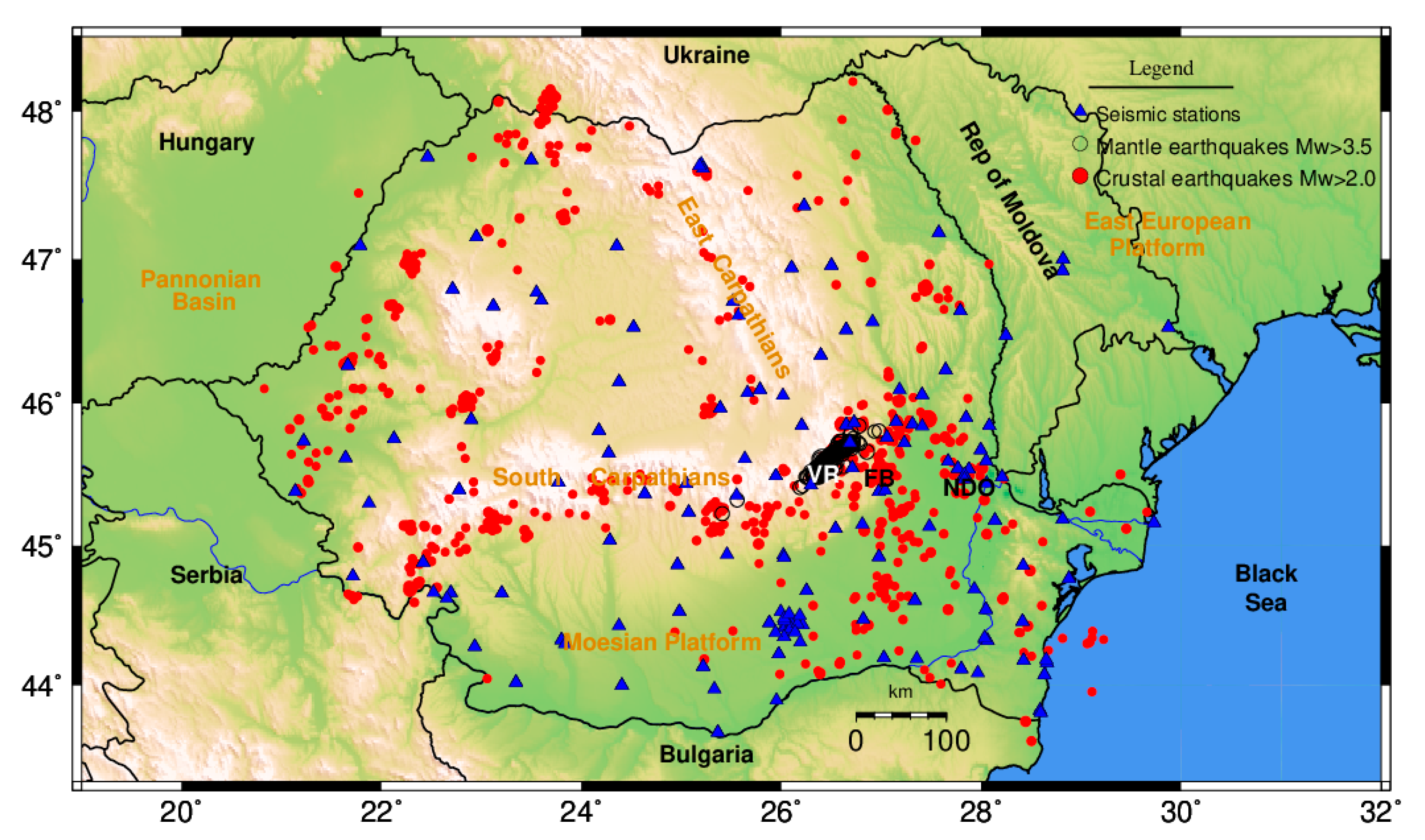
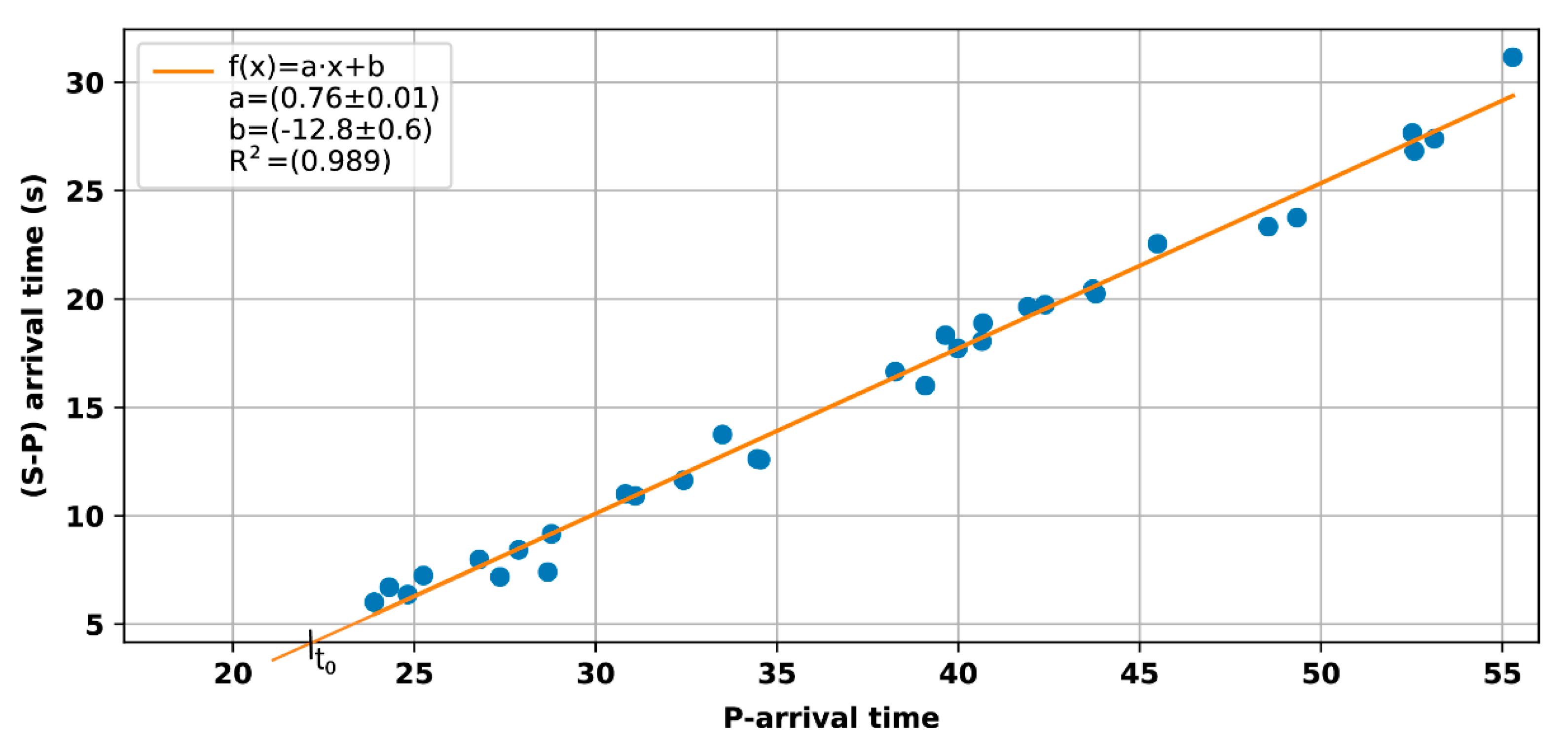
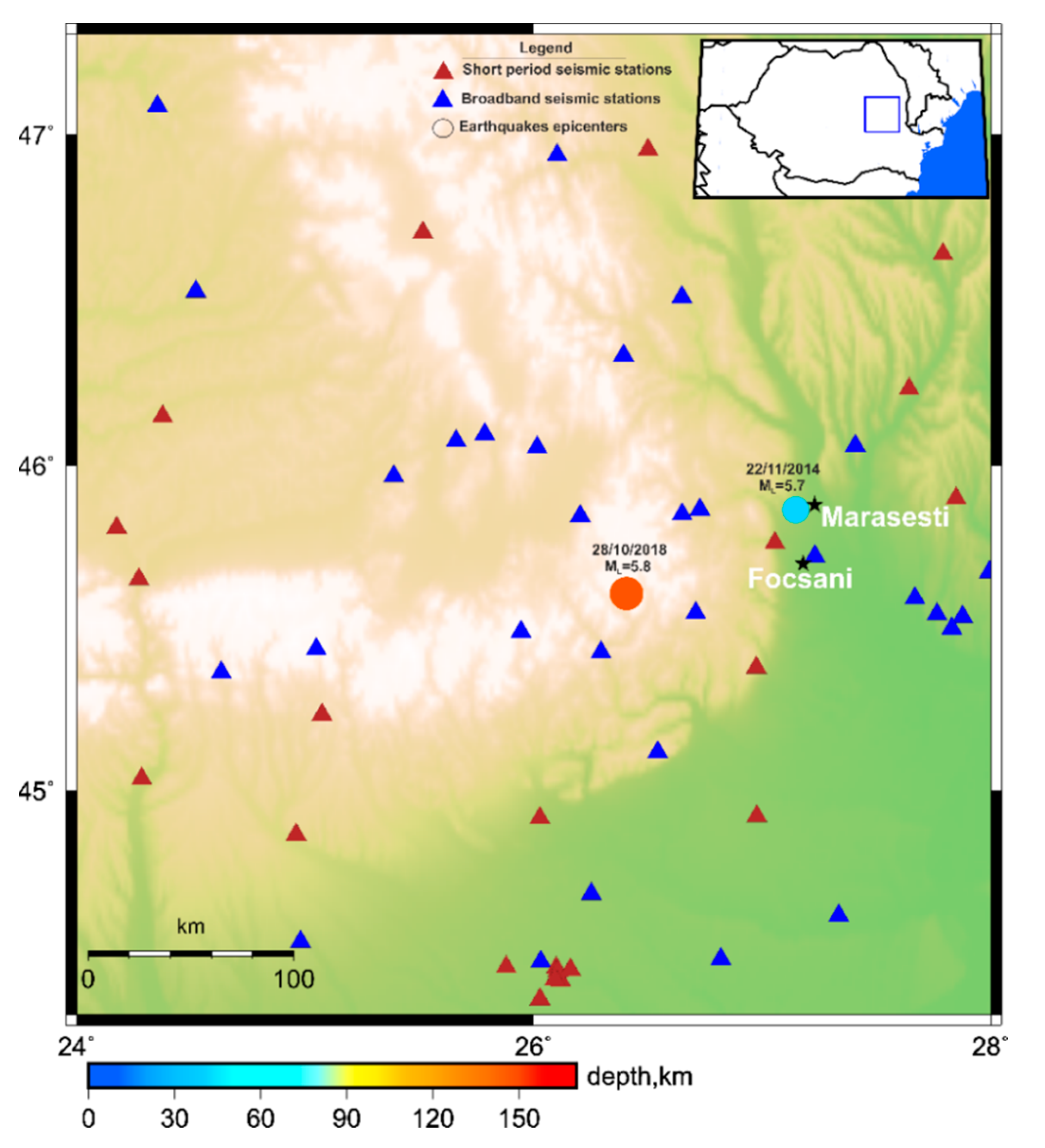
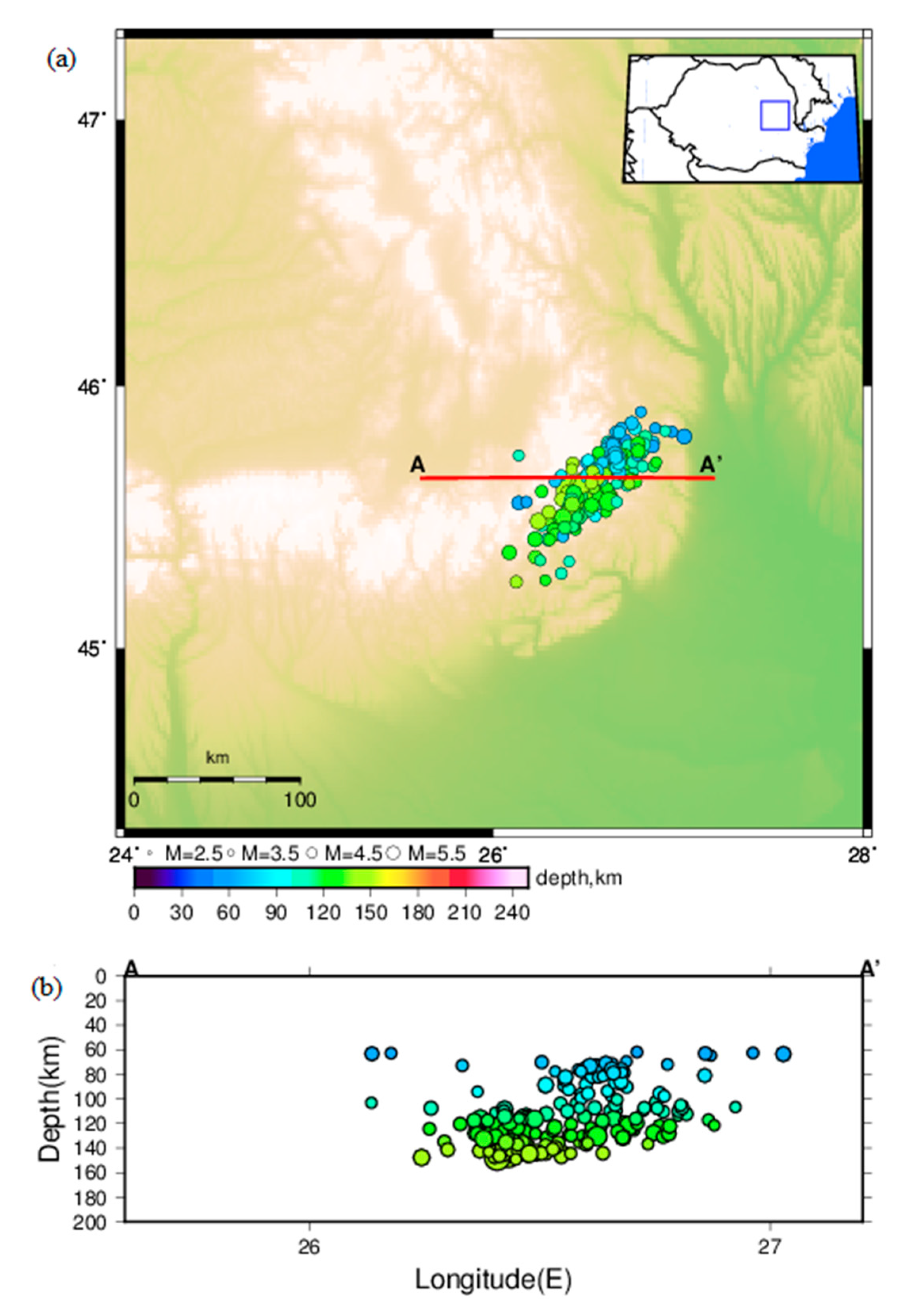
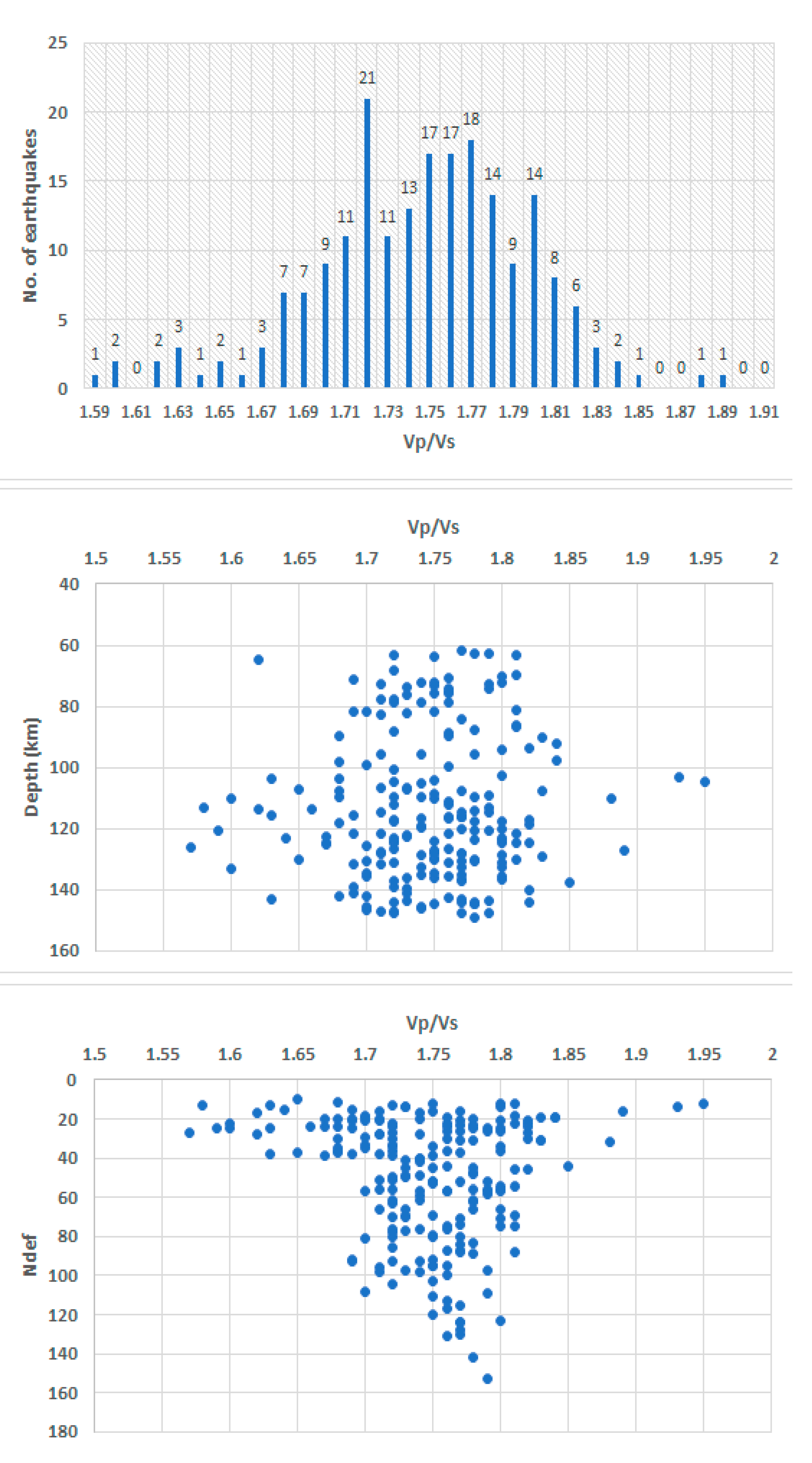
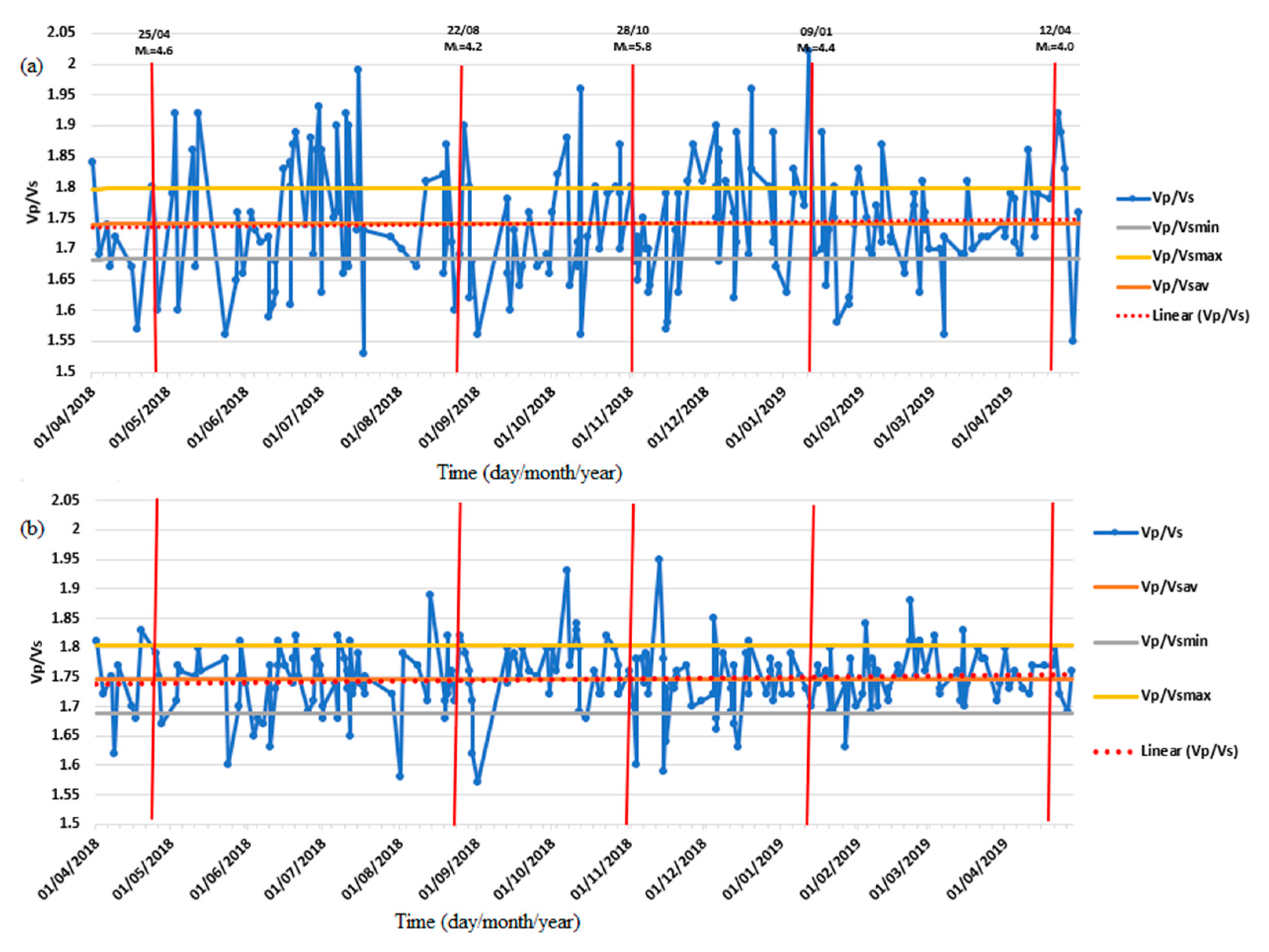
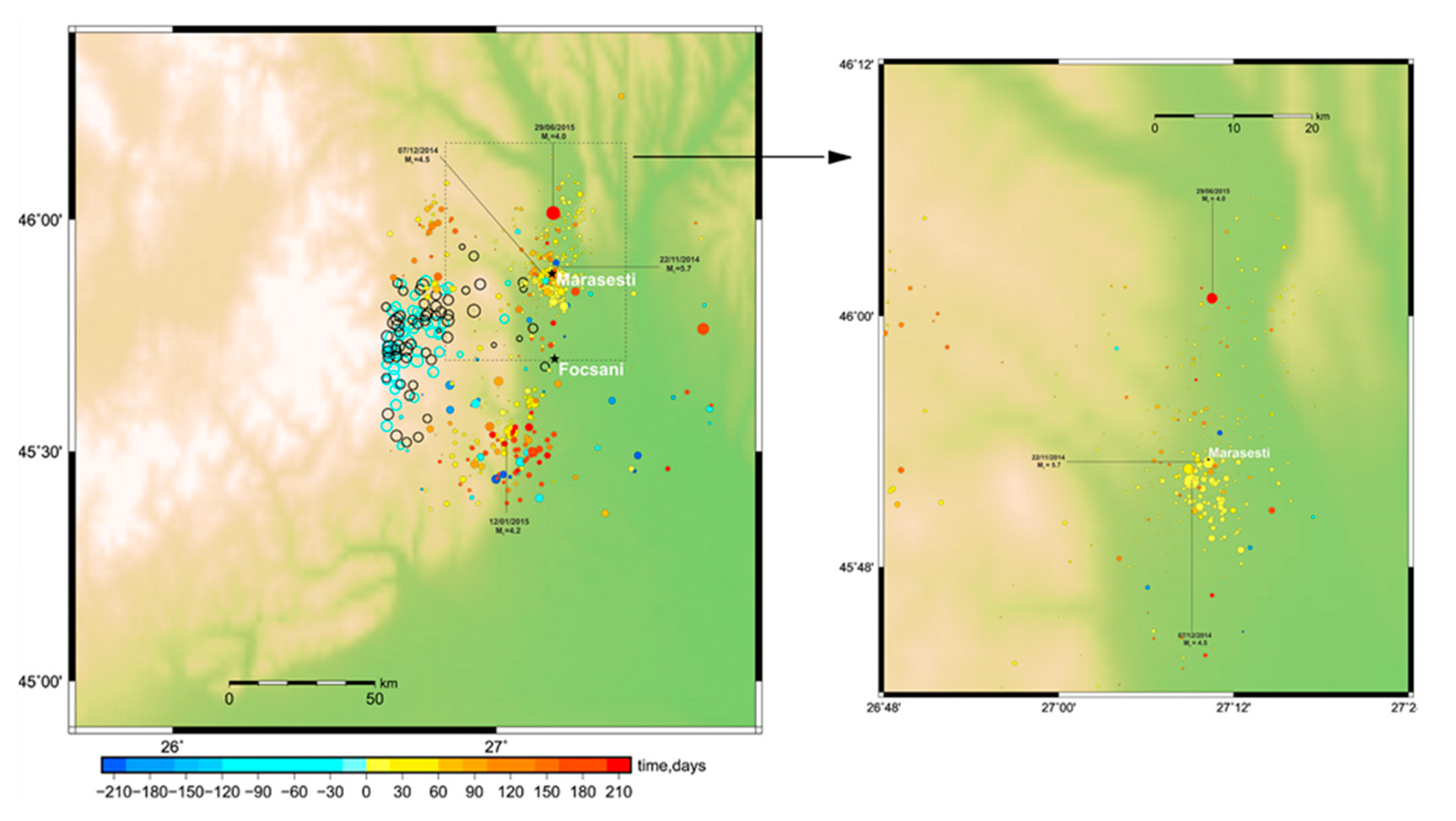
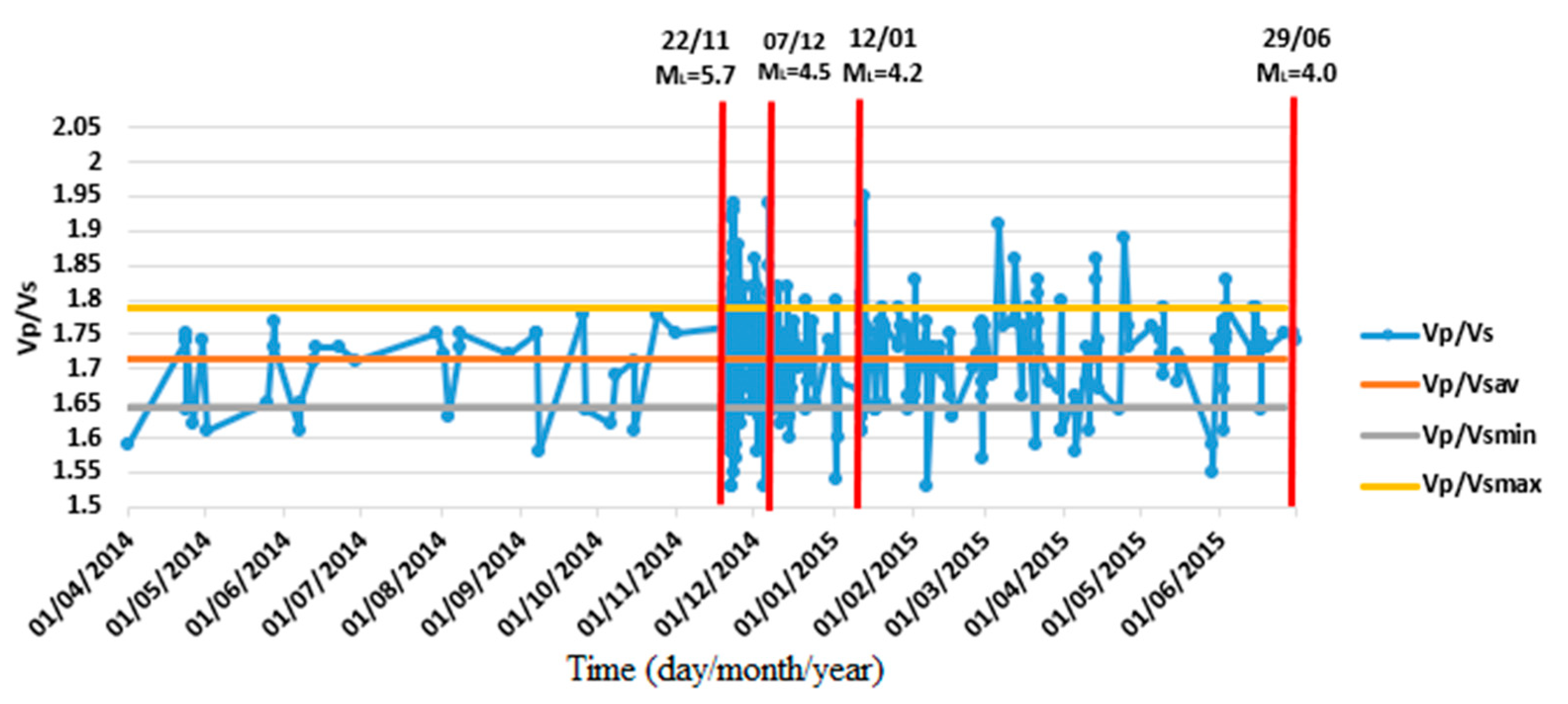

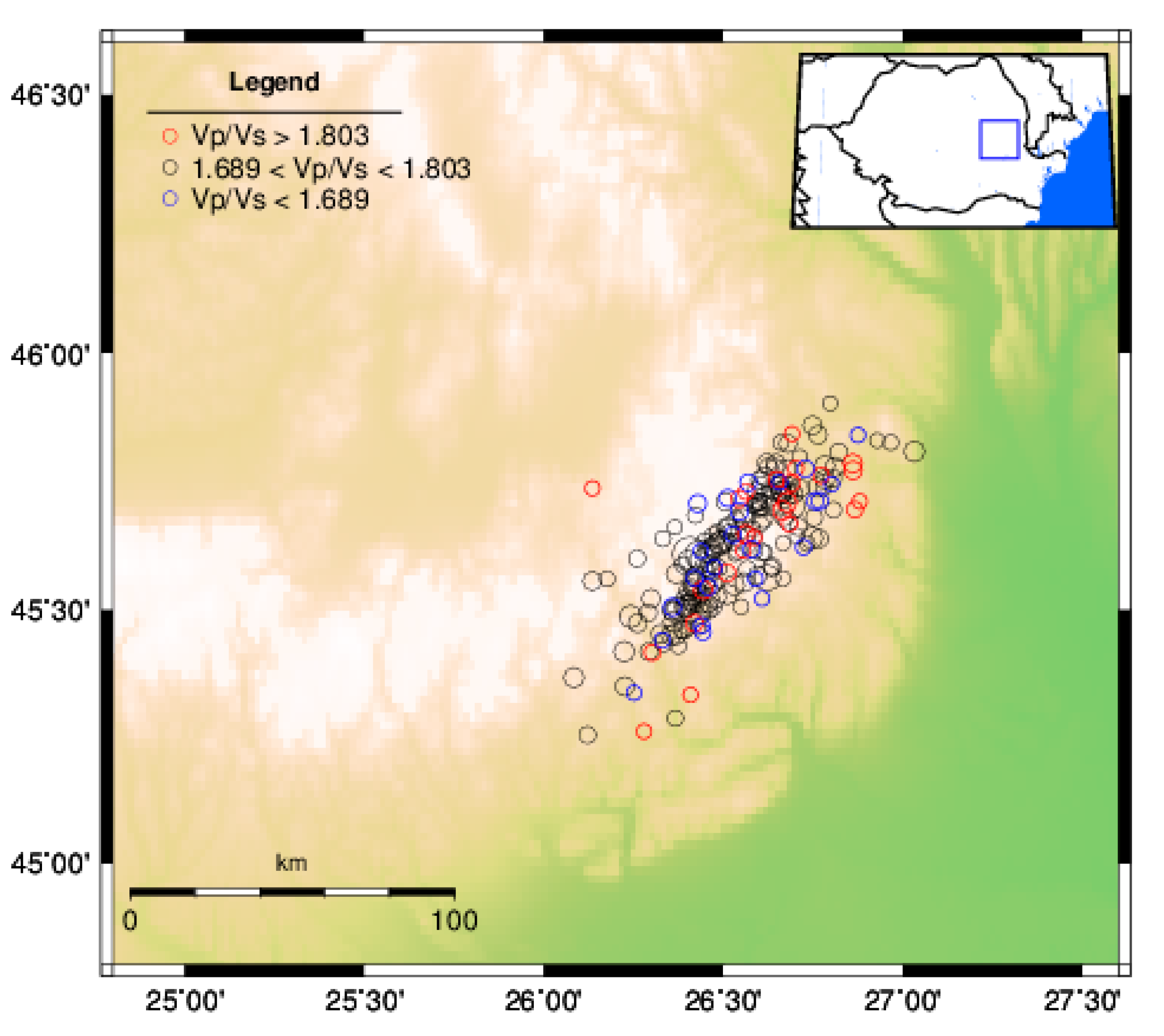

Publisher’s Note: MDPI stays neutral with regard to jurisdictional claims in published maps and institutional affiliations. |
© 2022 by the authors. Licensee MDPI, Basel, Switzerland. This article is an open access article distributed under the terms and conditions of the Creative Commons Attribution (CC BY) license (https://creativecommons.org/licenses/by/4.0/).
Share and Cite
Placinta, A.-O.; Borleanu, F.; Moldovan, I.-A.; Coman, A. Correlation between Seismic Waves Velocity Changes and the Occurrence of Moderate Earthquakes at the Bending of the Eastern Carpathians (Vrancea). Acoustics 2022, 4, 934-947. https://doi.org/10.3390/acoustics4040057
Placinta A-O, Borleanu F, Moldovan I-A, Coman A. Correlation between Seismic Waves Velocity Changes and the Occurrence of Moderate Earthquakes at the Bending of the Eastern Carpathians (Vrancea). Acoustics. 2022; 4(4):934-947. https://doi.org/10.3390/acoustics4040057
Chicago/Turabian StylePlacinta, Anica-Otilia, Felix Borleanu, Iren-Adelina Moldovan, and Alina Coman. 2022. "Correlation between Seismic Waves Velocity Changes and the Occurrence of Moderate Earthquakes at the Bending of the Eastern Carpathians (Vrancea)" Acoustics 4, no. 4: 934-947. https://doi.org/10.3390/acoustics4040057




